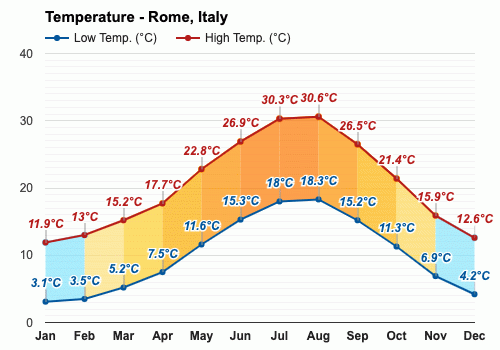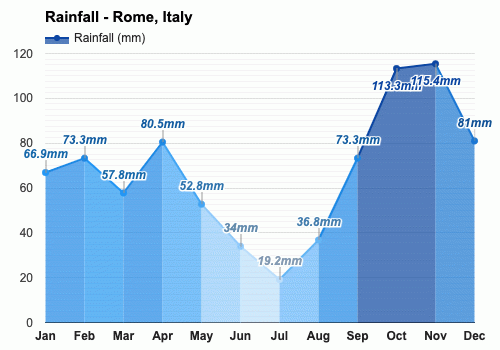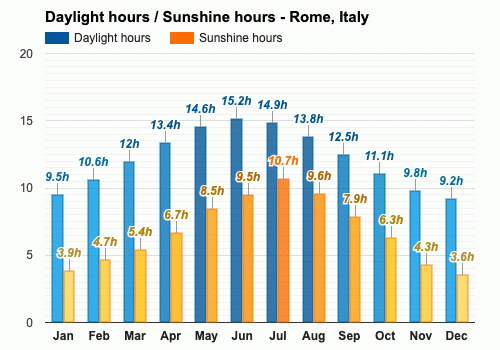Contents
- The climate of Rome
- The best time to visit Rome
- The worst time to visit Rome
- Spring weather in Rome
- Summer weather in Rome
- Autumn weather in Rome
- Winter weather in Rome
- Weather in January
- Weather in February
- Weather in March
- Weather in April
- Weather in May
- Weather in June
- Weather in July
- Weather in August
- Weather in September
- Weather in October
- Weather in November
- Weather in December
- Frequently asked questions
- Average temperature
- Average rainfall
- Average rainfall days
- Average daylight
- Average sunshine
- Average UV index

The climate of Rome
A distinct characteristic of Rome's climate is the oscillation between monthly temperatures. Based on available data, temperatures can fluctuate from a brisk 3.1°C (37.6°F) in January to a blistering 30.6°C (87.1°F) in August. Rainfall also follows a pattern throughout the year, peaking at 115mm (4.53") in November and shrinking to as low as 19mm (0.75") in July. Observing the daylight hours, Rome enjoys a maximum of 15.2 hours in June and a minimum of 9.2 hours in December.
One unique aspect about Rome's weather conditions is the frequency of sunshine hours in the summer. Extended periods of sunlight reaching up to 10.7 hours are recorded in July. Concurrently, there is a surge in the UV index in July, reaching 9. Rainfall days exhibit a different trend - mostly concentrated in the late autumn and early winter months, specifically November (9.7 days) and December (8 days).
The best time to visit Rome
The worst time to visit Rome
Spring weather in Rome
Summer weather in Rome
Autumn weather in Rome
Winter weather in Rome
Weather in January
Weather in February
Weather in March
Weather in April
Weather in May
Weather in June
Weather in July
Weather in August
Weather in September
Weather in October
Weather in November
Weather in December
Published by: Weather Atlas | About Us
Data Sources | Weather Forecasting & Climate
Frequently asked questions
What is the coldest time of year in Rome?
How much does it rain in Rome?
When are the longest days in Rome?
What is the driest month in Rome?
What month has the most sunshine in Rome?
What is the month with the highest UV index in Rome?
What is the hottest time of year in Rome?
When is Daylight Saving Time (DST) in Rome?
What is the wettest month in Rome?
What is the month with the shortest days in Rome?
What is the month with the least sunshine in Rome?
When is the lowest UV index in Rome?
Average temperature
Rome, Italy

The warmest month (with the highest average high temperature) is August (30.6°C).
The month with the lowest average high temperature is January (11.9°C).
The month with the highest average low temperature is August (18.3°C).
The coldest month (with the lowest average low temperature) is January (3.1°C).
Average rainfall
Rome, Italy

- Average rainfall in January:
66.9mm - Average rainfall in February:
73.3mm - Average rainfall in March:
57.8mm - Average rainfall in April:
80.5mm - Average rainfall in May:
52.8mm - Average rainfall in June:
34mm
- Average rainfall in July:
19.2mm - Average rainfall in August:
36.8mm - Average rainfall in September:
73.3mm - Average rainfall in October:
113.3mm - Average rainfall in November:
115.4mm - Average rainfall in December:
81mm
The wettest month (with the highest rainfall) is November (115.4mm).
The driest month (with the least rainfall) is July (19.2mm).
Average rainfall days
Rome, Italy

- Average rainfall days in January:
7 days - Average rainfall days in February:
7.6 days - Average rainfall days in March:
7.6 days - Average rainfall days in April:
9.2 days - Average rainfall days in May:
6.2 days - Average rainfall days in June:
4.3 days
- Average rainfall days in July:
2.1 days - Average rainfall days in August:
3.3 days - Average rainfall days in September:
6.2 days - Average rainfall days in October:
8.2 days - Average rainfall days in November:
9.7 days - Average rainfall days in December:
8 days
The month with the highest number of rainy days is November (9.7 days).
The month with the least rainy days is July (2.1 days).
Average daylight / Average sunshine
Rome, Italy

- Average daylight in January:
9h and 3min - Average daylight in February:
10h and 4min - Average daylight in March:
12h and 0min - Average daylight in April:
13h and 2min - Average daylight in May:
14h and 4min - Average daylight in June:
15h and 1min
- Average daylight in July:
14h and 5min - Average daylight in August:
13h and 5min - Average daylight in September:
12h and 3min - Average daylight in October:
11h and 1min - Average daylight in November:
9h and 5min - Average daylight in December:
9h and 1min
The month with the longest days is June (Average daylight: 15h and 12min).
The month with the shortest days is December (Average daylight: 9h and 12min).
- Average sunshine in January:
3h and 5min - Average sunshine in February:
4h and 4min - Average sunshine in March:
5h and 2min - Average sunshine in April:
6h and 4min - Average sunshine in May:
8h and 3min - Average sunshine in June:
9h and 3min
- Average sunshine in July:
10h and 4min - Average sunshine in August:
9h and 4min - Average sunshine in September:
7h and 5min - Average sunshine in October:
6h and 2min - Average sunshine in November:
4h and 2min - Average sunshine in December:
3h and 4min
The month with the most sunshine is July (Average sunshine: 10h and 42min).
The month with the least sunshine is December (Average sunshine: 3h and 36min).
Average UV index
Rome, Italy

The month with the highest UV index is July (UV index 9).
The month with the lowest UV index is December (UV index 1).
Rome, Italy
Weather forecast for your location
2. Allow the app to use your location


